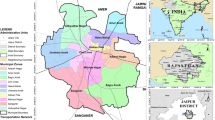Abstract
This study contributes to the worldwide effort to update the status of mangroves, assessing a large mangrove distribution area in Mexico by analyzing Landsat MSS from the early 1970s and TM imagery from 2005. Four states (Baja California Sur, Sonora, Sinaloa, and Nayarit) integrate the northwest region of Mexico, where the mangrove area was estimated to be around 180,000 ha on both dates, with a reduction of about 2% by 2005. Nayarit by itself had a large decrease (>10,000 ha), while the other states increased their mangrove extent from 4 to 15%. However, this increase was probably a consequence of improved satellite capabilities in 2005 rather than mangrove expansion. Mangrove condition, measured through a normalized difference vegetation index (NDVI), was categorized into four types based in the index value distributions. Type 1, representing the poorest condition, included values below the first quartile (Q1), while Type 4, the best condition, was indicated by values above Q3. One of the intermediate categories (Type 3) was dominant, accounting for >40% of the total mangrove surface in both the 1970s and 2005. Mangrove systems in northwest Mexico have different conditions of stress, and thus different management strategies should be identified to preserve and maintain those systems.


Similar content being viewed by others
References
Alongi DM (2008) Mangrove forests: resilience, protection from tsunamis, and responses to global climate change. Estuar Coast Shelf Sci 76:1–13
Belward AS (1991) Spectral characteristics of vegetation, soil and water in invisible, near infrared and middle-infrared wavelengths. In: Belward AS, Valenzuela CR (eds.) Remote sensing and geographical information systems of resource management in developing countries. Kluwer Ac. Publ. Commission European Communities, pp 31–53.
Berlanga-Robles CA, Ruiz-Luna A (2006) Assessment of landscape changes and their effects on the San Blas estuarine system, Nayarit (Mexico), through Landsat imagery analysis. Ciencias Marinas 32:523–538
Berlanga-Robles CA, Ruiz-Luna A (2007) Análisis de las tendencias de cambio del bosque de mangle del sistema lagunar Teacapán-Agua Brava, México. Una aproximación con el uso de imágenes de satélite Landsat. Universidad y Ciencia. Trópico Húmedo 23:29–46
Charuppat T, Charuppat J (1997) Application of LANDSAT-5 (TM) for monitoring the changes of mangrove forest area in Thailand. In: Proceedings of the Tenth Thai National Seminar on Mangrove Ecology, 25–28 August 1997. Paper I-9. National Research Council of Thailand, Hat Yai, Thailand
CONABIO (2008) Manglares de México. Comisión Nacional para el Conocimiento y Uso de la Biodiversidad, México
Congalton RG, Green K (1999) Assessing the accuracy of remotely sensed data: principles and practices. Lewis Publisher, USA
FAO (2003) Status and trends in mangrove area extent worldwide. By Wilkie ML, Fortuna S, Forest Resources Assessment Working Paper No. 63. Forest Resources Division. Food and Agriculture Organization of the United Nations. Rome. Available via http://www.fao.org/docrep/007/j1533e/j1533e00.HTM. Accessed 28 Jan 2010
FAO (2007) The World’s mangroves 1980–2005. FAO Forestry Paper 153. Food and Agriculture Organization of the United Nations. Rome.
Gilabert MA, González-Piqueras J, García-Haro J (1997) Acerca de los índices de vegetación. Rev Teledetec 8:35–45
Green EP, Mumby PJ, Edwards AJ, Clark CD (1996) A review of remote sensing for the assessment and management of tropical coastal resources. Coast Manage 24:1–40
Green EP, Clark CD, Mumby PJ, Edwards AJ, Ellis AC (1998) Remote sensing techniques for mangrove mapping. Int J Remote Sens 19:935–956
Hansen M, Burk T (1998). Integrated tools for natural resources inventories in the 21st century. Proceedings. Idaho. USA
Kovacs JM, Wang J, Blanco-Correa M (2001) Mapping disturbance in a mangrove forest using multi-date Landsat TM imagery. Environ Manage 27:763–776
Mehlig U (2006) Phenology of the red mangrove, Rhizophora mangle L., in the Caeté Estuary, Pará, equatorial Brazil. Aquat Bot 84:158–164
Paling EI, Kobryn HT, Humphreys G (2008) Assessing the extent of mangrove change caused by cyclone Vance in the eastern Exmouth Gulf, northwestern Australia. Estuar Coast Shelf Sci 77:603–613
Ramsey EW III, Jensen JR (1996) Remote sensing of mangrove wetlands: relating canopy spectra to site-specific data. Photogramm Eng Remote Sensing 62:939–948
Ruiz-Luna A, Acosta-Velázquez J, Berlanga-Robles CA (2008) On the reliability of the data of the extent of mangroves; a case study in Mexico. Ocean Coast Manage 51:342–351
Stuart SA, Choat B, Martin KC, Holbrook NM, Ball MC (2007) The role of freezing in setting the latitudinal limits of mangrove forest. New Phytol 173:576–583
Acknowledgments
We thank CONACYT and CONAGUA for financial assistance to the FONSEC CNA 48216 project and the authors.
Author information
Authors and Affiliations
Corresponding author
Rights and permissions
About this article
Cite this article
Ruiz-Luna, A., Cervantes Escobar, A. & Berlanga-Robles, C. Assessing Distribution Patterns, Extent, and Current Condition of Northwest Mexico Mangroves. Wetlands 30, 717–723 (2010). https://doi.org/10.1007/s13157-010-0082-2
Received:
Accepted:
Published:
Issue Date:
DOI: https://doi.org/10.1007/s13157-010-0082-2




